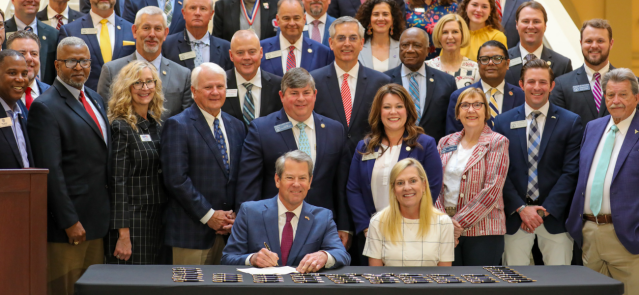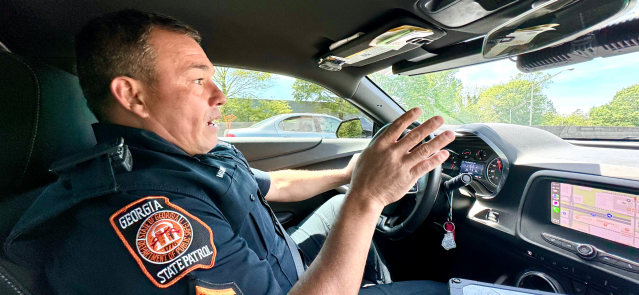Stay ahead of the curve as a political insider with deep policy analysis, daily briefings and policy-shaping tools.
Request a DemoGeorgia’s Aging Bridge Problem

Illustration by Brittney Phan (State Affairs)
- 40% of Georgia Bridges are 50+ years old.
- Bridges built before 1980 were built for a 50-year lifespan.
- A booming population and economy mean more freight and heavier trucks put a strain on infrastructure built for lower loads.
In 2017, local officials in northwest Georgia identified five bridges that could not bear the weight of a school bus. The news was so stunning that citizens of Walker County voted to raise their own taxes to pay for road and bridge maintenance the following year.
But while much of Georgia faces a similar infrastructure crisis, it lacks the same will to fix the problem. Nearly half of Georgia’s state and locally managed bridges are near or past their estimated lifespan. And taxes aren't going up to pay for it.
“For every bridge that we replace there are several more that have reached their design life of 50 years,” Georgia Department Of Transportation (GDOT) Chief Engineer Meg Pirkle told the House Transportation Committee in a presentation last month.
As half of Georgia's infrastructure nears its unofficial expiration date, businesses are pushing to increase the weight limits of trucks on Georgia roads. Already Georgia’s booming population and economic growth have put an unforeseen strain on infrastructure. It could be a crisis in the making if officials don’t act on the data. While costs to replace individual bridges vary, usually, a couple of million dollars for a local bridge. The scale of the work needed statewide is likely in the hundreds of millions to billions of dollars in the next decade to replace the hundreds of bridges that have reached their life expectancy.

The GDOT implemented replacement of the Mitchell Street bridge in Atlanta pictured here in 2010, cost $8.8 million, and was funded in part by the Obama administration's American Recovery and Reinvestment Act. (Credit: Cedric Mohr/ Georgia Department of Transportation)
The problem
Georgia bridges are getting old. A significant number were built in the 50s, 60s, and 70s, and while bridges built from the 1980s onwards were built to a 75-year expected lifespan, older bridges were built to last just 50 years.
There’s also a push to increase the gross vehicle weight limits for trucks, which would be a boon to businesses, but state transportation officials fear would accelerate the deterioration of bridges, especially those managed by local governments. Already 97% of bridges posted for weight restrictions are local bridges.
Studies done in Texas and South Carolina for those states' respective Departments of Transportation show that the increase of vehicle weights causes exponentially more damage to roads and bridges.
“We would see drastic impacts,” Pirkle said of those findings in a presentation to legislators last month.
At the same time, legislators and local officials are generally positive about GDOT’s ability to take on the challenge of aging infrastructure.
The average age of a bridge in the state is 42.6 years, with state-managed bridges averaging 41 years and local, county-managed bridges averaging 44 years of age, according to GDOT.
“When I'm referring to myself I'll say 50 is the new 30 but when referring to a bridge 50 is old,” Pirkle said.
 Georgia's bridges are aging beyond their average 50-year lifespan across the state. (Credit: Brittney Phan for State Affairs)
Georgia's bridges are aging beyond their average 50-year lifespan across the state. (Credit: Brittney Phan for State Affairs)
According to GDOT, there are 14,769 bridge structures across the state with 6,819 managed by the state and 8,004 managed by local city and county governments. While the vast majority of these are rated to be in “good” or “fair” condition, some 243 bridges are considered to be in “poor” condition. And some 40% or about 5,900 bridges are 50 years old or older.
And while Pirkle defended the state’s record on bridge maintenance and repair, she said that there comes a point where replacement is needed. “Bridge maintenance does not restore a bridge,” she said.
“Think about it if you get a knee replaced when you're 50 it will let you keep playing tennis a little bit longer but you're still 50 it doesn't make you 21 again… even with good maintenance bridges that have reached their useful life need to be replaced,” she said.
“I think we are we are looking at what could potentially be a crunch but I also think that GDOT and the state are approaching this in a very thoughtful way and so the bridges and roads that are in the most need of repair are definitely being prioritized,” said Teri Anulewicz (D- Smyrna), a State Representative who sits on the House Transportation Committee.
Anulewicz is also confident that both Republican and Democrat legislators would work together to find data-driven solutions.
“I don't hold my breath when I drive over any bridges in Georgia,” she said.
“We're making progress, but we have a little ways to go,” she said. “GDOT is willing and eager to innovate because I think that we're going to need a lot of innovation.”
 A 2011 view of the new Sidney Lanier Bridge in Brunswick, which opened in 2003 and cost $65 million to build. The original bridge was built in 1953 and was struck twice by ships. (Credit: Cedric Mohr/ Georgia Department of Transportation)
A 2011 view of the new Sidney Lanier Bridge in Brunswick, which opened in 2003 and cost $65 million to build. The original bridge was built in 1953 and was struck twice by ships. (Credit: Cedric Mohr/ Georgia Department of Transportation)
Bridge money at work
While the American Society of Civil Engineers gave Georgia a C+ for bridge infrastructure in its latest report card, that’s actually better than most states, and Georgia is one of the few states to see improvement on its grade from previous years. According to the US Department of Transportation, there are 374 bridges rated to be in “poor” condition and that poor roads and bridges cost drivers $375 per year.
Anulewicz said that in addition to freight, the new paradigm of e-commerce, which accelerated during the pandemic, means that the logistics of last-mile delivery and the impact of the rise of delivery vans on the road is something that needs to be considered.
“All of it is a lot more wear and tear on the roads. I think commerce is a good thing. But how do we account for this?”
In 2015 the Georgia Legislature authorized a $100 million annual bridge bond which greatly expanded the amount of money available to repair and replace bridges. GDOT has implemented programs to assist with bridges managed by county governments. The low-impact bridge program has replaced 36 bridges since 2014, with another 54 planned or under construction for a total cost of $54 million so far. A separate local bridge replacement program replaced 24 structurally deficient local bridges for a cost of $39.6 million between 2017 and 2019. 
The 14th Street Bridge replacement project in Atlanta cost $90 million in 2009. (Credit: Cedric Mohr/Georgia Department of Transportation)
GDOT’s bridge bond “has been a game-changer for poor local communities because if it wasn't for that it'd be terrible,” said Kevin Tanner, Forsyth County’s manager who previously chaired the House Transportation Committee as a four-term Republican State Representative serving the Dawsonville area. But the north-Atlanta area county has a wealthy and growing tax base, it is among the few counties that can fund its own bridge repairs, though it too taps into state funds.
“We have financial resources here in Forsyth County that there's a lot of folks not blessed in their communities to have, so that does put us at an advantage,” he said, adding “with all of that we do have a greater need than most counties in Georgia also because we have more roads we have more traffic congestion.”
With President Joe Biden’s infrastructure bill signed into law in November, Georgia can expect more money to help address the infrastructure needs it faces. The US Department of Transportation estimates that over the next 5 years Georgia should get $225 million for bridge replacement and repair. The bill also makes $12.5 billion available for all states to compete over to fund work on bridges specifically.
Tanner, who in Forsyth County has recently overseen two bridge replacements in the county at a cost of $4.35 million, says that while federal dollars are welcome, counties and the state should leverage local resources to match those dollars when applying for grants. The number of permits issued for oversize truck loads has increased in recent years across Georgia. (Credit: Brittney Phan for State Affairs)
The number of permits issued for oversize truck loads has increased in recent years across Georgia. (Credit: Brittney Phan for State Affairs)
What's up with weight limits?
But the push to increase freight weight limits in the state is an issue that has come up repeatedly in the legislature over the years. Several industries, notably forestry and concrete businesses, have pushed for weight limits to be increased from 80,000 to 100,000 pounds.
But GDOT estimates this would result in doubling the number of weight-restriction posted bridges in the state. County governments and the agency itself have generally opposed increasing the weight restrictions.
“Increasing the loads on these bridges will only accelerate the deterioration and eventually the fatigue will prevail,” Pirkle told legislators. “Also keep in mind not only are these bridges reaching their design life but those bridges designed in the 70s and prior were designed for much less stress than we expect of our bridges today.”
Part of that is that the engineering standards for bridge construction to this day continue to use truck design loads established in 1944, she said.  The number of permits for oversize truck loads has increased steadily over the last decade in Georgia. (Credit: Brittney Phan for State Affairs)
The number of permits for oversize truck loads has increased steadily over the last decade in Georgia. (Credit: Brittney Phan for State Affairs)
But industry advocates say they’re feeling the squeeze from a nationwide shortage of truck drivers, and that Georgia has lower weight limits than many neighboring states, putting Georgia businesses that rely on trucking their products to market at a competitive disadvantage. Alabama, Florida, and Tennessee allow 88,000 pounds in vehicle weight.
“Georgia’s forest economy is the largest in the nation, but it is being stretched to a breaking point due to a lack of available truck drivers, the highest insurance rates in the Southeast, and the lowest truck weights in the Southeast,” said Andres Villegas, President & CEO of the Georgia Forestry Association, in a statement to State Affairs.
Villegas said the result is a higher cost for consumers on goods ranging from toilet paper to lumber. The Georgia Forestry Association represents over 500 logging businesses and estimates they put about 3,500 log trucks on Georgia roads that haul some 50 million tons of wood per year. Liability insurance premiums for log trucks increased by 53% between 2011-2016 and during the same period, premiums for other heavy vehicles increased only by 12%, according to the American Trucking Association.
“While there is no silver bullet that would solve each of these problems, we hope to work with state DOT and county officials to find a solution that will allow us to increase truck weights and also keep our roads safe and our rural economy thriving,” he said.
Even so, over the past decade, Georgia has issued more and more oversize permits to trucks that allow them to transport up to 100,000 pounds. According to Department of Public Safety records obtained by State Affairs, in 2011 Georgia issued about 17,154 such permits, in 2020, the most recent year where complete data was available, Georgia issued 21,116, a nearly 25% increase.
 A view of the Talmadge Memorial Bridge in Savannah in 2013. Originally built in 1953, it was replaced in 1990 at a cost of $70.1 million. (Credit: Cedric Mohr/ Georgia Department of Transportation)
A view of the Talmadge Memorial Bridge in Savannah in 2013. Originally built in 1953, it was replaced in 1990 at a cost of $70.1 million. (Credit: Cedric Mohr/ Georgia Department of Transportation)
Legislators have repeatedly rejected past bills to raise weight limits, siding with concerns raised by GDOT as well as county and city governments that usually cannot pay for infrastructure repair or replacement without help from the state.
“It's not something I'm opposed to,” said Anulewicz, adding “but I think we need to understand that there is a cost attached to it and there aren't just costs attached for the state but also for different cities and counties… we have to have our eyes wide open to all of the potential consequences of what it is that we're doing.”
Kathleen Bowen, the associate legislative director for the ACCG, the association of Georgia’s County governments, pointed out that the vast majority of bridges posted for weight restrictions or closed to traffic are on local roads. More than 1,285 bridges in the state are posted for weight restrictions or are closed to traffic; 97% of these bridges are on local roads.
“It takes a combination of funding sources to tackle the number of bridges that need replacing. Many counties would be unable to replace their bridges without the assistance of GDOT,” she said.
Besides state and federal funding, the primary source of funding for counties wanting to invest in infrastructure is through their local sales tax such as the Special Purpose Local Option Sales Tax (SPLOST) or the Transportation Special Purpose Local Option Sales Tax (TSPLOST).
The ACCG’s priority for the 2022 legislative session, she said, is that GDOT, the governor, and the legislature continue to prioritize working on bridges that are closed or posted for weight restrictions.
How do you feel about the bridges and roads in your county and city? Are there bridges you rely on for your business that are in poor condition? Share your thoughts and feedback on this story: [email protected].
Read this story for free.
Create AccountRead this story for free
By submitting your information, you agree to the Terms of Service and acknowledge our Privacy Policy.
Kemp signs bills on education, health care, taxes
Gov. Brian Kemp signed a slew of bills over the past week or so, including the private school voucher bill long sought by Republicans and a bill that will ease regulations over the construction and expansion of medical facilities in rural areas. His bill-signing events were clustered into themes: education, health care, military members, human …
Incumbent candidates for local, federal races likely to be no-shows at this weekend’s primary debates
ATLANTA — One of Georgia’s prominent media organizations is pleading with incumbent state and congressional candidates to participate in its primary election debates slated for Sunday.
For the first time in The Atlanta Press Club’s 30-year debate history, incumbents facing challengers in the May 21 primary have either declined or not yet committed to participating in the organization’s well-known debate series. The possible no-shows include candidates in four Congressional races as well as the Georgia Supreme Court, and the Fulton County District Attorney races.
“This is the first time that we’ve had so many [incumbents] not participate,” debate organizer Lauri Strauss told State Affairs. Strauss declined to speculate why candidates aren’t participating.
Hoping to encourage more participation, the organization issued the following statement:
“The Atlanta Press Club believes it is the responsibility of people running for public office to answer questions from their local media that will help inform voters before they cast their ballots. If a candidate is running for public office, the candidate should be willing to participate in the democratic process, which includes attending debates and fielding questions from journalists and opponents.”
Candidates have until Friday to RSVP.
Strauss said candidates who fail to appear will be represented on stage by an empty podium during the debate.
District Attorney Fani Willis has declined to participate and Democratic U.S. Reps. Lucy McBath and David Scott have yet to RSVP. Strauss said the organization is still in talks with Georgia Supreme Court Justice Andrew Pinson’s staff about his appearance in the debate.
Willis, declined earlier this week to participate, citing constraints around talking about sensitive cases like the criminal prosecution of former President Donald Trump.
McBath currently represents the 7th Congressional District and is now running in the newly drawn 6th Congressional District against two Democratic challengers, Jerica Richardson and Mandisha Thomas. McBath declined to participate in the press club’s general election debate in 2022, forcing her Republican challenger Mark Gonsalves to debate with an empty podium. McBath won with 61% of the vote.
The debates will air live on April 28 on GPB.org, on The Atlanta Press Club’s Facebook page (www.fb.com/TheAtlantaPressClub). It will be rebroadcast in early May on WABE.org.
| Race | Tape and Livestream Sun. April 28 |
GPB-TV Broadcast | WABE Broadcast |
| Congressional District 6 Democrats | 10:00 a.m. | April 29 at 7:00 p.m. | May 1 at 4:30 p.m. |
| Congressional District 13 Democrats | 11:15 a.m. | April 28 at 4:00 p.m. | May 1 at 5 p.m. |
| Congressional District 3 Republicans | 1:00 p.m. | April 28 at 5:00 p.m. | May 2 at 3:30 p.m. |
| Congressional District 2 Republicans | 3:00 p.m. | April 29 at 5:00 p.m. | |
| Georgia Supreme Court | 4:45 p.m. | May 2 at 4:30 p.m. | |
| DeKalb County CEO | 5:45 p.m. | May 2 at 5:15 p.m. | |
| Fulton County District Attorney | 6:45 p.m. | May 1 at 4 p.m. |
Have questions or comments? Contact Jill Jordan Sieder on X @journalistajill or at [email protected] and Tammy Joyner on X @lvjoyner or at [email protected].
And subscribe to State Affairs so you do not miss an update.
X @StateAffairsGA
Instagram@StateAffairsGA
Facebook @StateAffairsGA
LinkedIn @StateAffairs
‘It is nothing short of insane:’ Bill to criminalize squatting signed by governor
ATLANTA — Today Gov. Brian Kemp signed legislation criminalizing squatting, the illegal practice of entering and residing on someone else’s property without their consent. The Georgia Squatter Reform Act makes squatting a misdemeanor criminal offense, punishable by up to a year in jail, a $1,000 fine, or both. It also speeds up the timeline to …
State troopers are stretched to fight drugs and curb highway deaths
ATLANTA — When Cpl. Anthony Munoz straps on his bullet-proof vest each day and pulls out of the Department of Public Safety headquarters in Atlanta, Munoz never knows how his shift will unfold. What is for certain is that the traffic — of cars, criminals and contraband — is constant. And what is also true …




